How to Cite | Publication History | PlumX Article Matrix
Chromosomal Aberrations Induced by Carbaryl in Root Meristem Cells of Pisum Sativum L.
Khushboo Kushwah, Ravendra Singh Chauhan, R. K. Sarbhoy and Harshal Kumar
Department of Botany, Agra College Agra: 282002 (U.P.) India.
DOI : http://dx.doi.org/10.13005/bbra/2532
ABSTRACT: Carbaryl, which is also known as sevin, induced mitostatic and turbagenic leading to clastogenic effects in the root meristem cells of Pisum sativum. The study was conducted at Department of Botany, Agra College, Agra. Seeds of uniform size of Pisum sativum were germinated on moist filter paper in petriplates. 1to 2 mm root tips were cut and treated with different concentrations (0.1, 0.2, 0.3,0.5%) of carbaryl prepared in distilled water for varying duration (3 to 9 hrs.) of time. It has mitodepressive and mitostatic effects on somatic cell division. These effects are directly proportional to concentration and duration. Common clastogenic effects are stickiness, condensation, breakage and bridges etc. Present investigation clearly revealed that carbaryl showed clastogenic and mitostatic effects. So, it should be used with precautions as it can be hazardous to both targeted and non-targeted biota.
KEYWORDS: Chromosomal Aberration;Carbaryl Pisum sativum;
Download this article as:| Copy the following to cite this article: Kushwah K, Chauhan R. S, Sarbhoy R. K, Kumar H. Chromosomal Aberrations Induced by Carbaryl in Root Meristem Cells of Pisum Sativum L. Biosci Biotech Res Asia 2017;14(3). |
| Copy the following to cite this URL: Kushwah K, Chauhan R. S, Sarbhoy R. K, Kumar H. Chromosomal Aberrations Induced by Carbaryl in Root Meristem Cells of Pisum Sativum L. Biosci Biotech Res Asia 2017;14(3). Available from: https://www.biotech-asia.org/?p=27209 |
Introduction
Carbaryl is a wide spectrum synthetic carbamate insecticide used to control over 100 species of insects on citrus fruit, cotton, forests, lawns, ornamentals and other crop as well as poultry, livestock and pets. It is a contact poison and also used as a molluscicides and acaricides. Carbaryl is a naphthalene derivative which is also known as sevin, septen and 1-naphthyl N-methyl carbamate. Its chemical formula is C12H11NO2. Carbaryl was first synthesized and introduced as an insecticide by Labrech in 1953 nad 1958 respectively. It is gobally used and considered to be environmentally less toxic due to non – persistent nature. Hence, it is more acceptable than the environmentally hazardous organochlorine and organophosphate pesticides.10
A variety of toxic effects of carbaryl have been observed on various stages of reproduction and genetic material of the animals exposed to it.4 Carbaryl has been shown to affect cell mitosis (cell division) and chromosomes in rats. It caused chromatid breaks, fragments and clumping of chromosomes in Culex.3 Environmental exposure to carbaryl may be associated with increased damage in DNA and damage in human sperms.11
Chromosomal aberrations in plants serve as excellent monitoring system for the detection of toxicity of chemicals that may pose genetic or environmental hazards. In the present paper an attempt have been made to screen the clastogenic and teratogenic effects of carbaryl using meristematic cells of Pisum sativum as test system.
Materials and Methods
The study was conducted at Department of Botany, Agra College, Agra. Seeds of uniform size of Pisum sativum were germinated on moist filter paper in petriplates. 1to 2 mm root tips were cut and treated with different concentrations (0.1, 0.2, 0.3,0.5%) of carbaryl prepared in distilled water for varying duration (3 to 9 hrs.) of time. The treated root tips were washed and then fixed in carnoys fixative for 6 hrs and finally transferred to 70% alcohol for longer storage. These fixed root tips were squashed in 1% acetocarmine. The slides were observed in high power microscope and important stages were photographed at magnification of 600x.
Results and Discussion
It has been observed from the foregoing that carbaryl induced different mitotic disturbances in the root meristematic cells of Pisum sativum. Chromosome fragmentation, stickiness, bridges and laggards were observed in different stages of the mitotic cycle. A decrease in mitotic index was observed after the treatment of root tips of Pisum with 0.1, 0.2, 0.3, 0.5% of carbaryl for 3-9 hrs duration. This concentration dependent decrease in mitotic index suggested a mitodepressive action of carbaryl which is comparable to that of other pesticides in Vicia faba1 and food dyes in Allium cepa.7
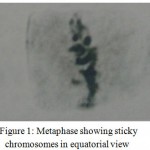 |
Figure 1: Metaphase showing sticky chromosomes in equatorial view |
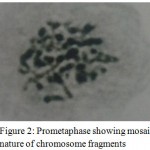 |
Figure 2: Prometaphase showing mosaic nature of chromosome fragments |
Carbaryl induced a number of chromosomal aberration and the frequency of abnormalities was concentration related. Chromosome bridges (Fig.4) and fragments (Fig.3) were common in all concentrations. The formation of bridges could be the result of union of large centric fragments at their distal ends.9
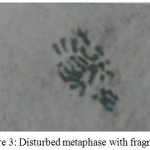 |
Figure 3: Disturbed metaphase with fragments |
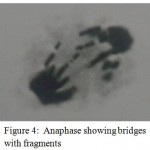 |
Figure 4: Anaphase showing bridges with fragments
|
Stickiness in chromosomes (Fig.1) was also observed. Stickiness has been attributed to an action on the proteins of chromosomes. Chromosome stickiness may be due to degradation or depolymerization of chromosome DNA.2
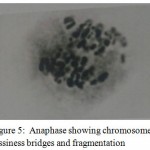 |
Figure 5: Anaphase showing chromosome fussiness bridges and fragmentation |
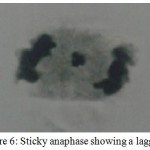 |
Figure 6: Sticky anaphase showing a laggard
|
Laggards (Fig.6) were also seen which may due to broken acentric chromosome fragment that are unable to get attached to a spindle fibre because of the absence of a centromere6. Disturbed metaphase (Fig. 3) and mosaic nature of chromosomes (Fig. 2) were also observed which may be due to an action of carbaryl on the spindle apparatus.8
Conclusion
It can be briefed from the above that carbaryl is a potent clastogenic agent which cause various types of chromosomal abnormalities in the root meristem cells of Pisum sativum. These abnormalities increased with the increase in concentration and duration of treatment. Various types of chromosomal aberration include stickiness, fragmentation, bridges and laggards. Carbaryl retarded the mitotic cycle and acted as mitotic poison. The clastogenic effects clearly divulge the toxic nature of carbaryl. Hence, it should be used at moderate level by skilled workers.
References
- Ghareeb A and Nelly George M. Cytologia. 1997;62:259-263.
CrossRef - Darlington D and McLeish L. Nature. 1951;167:407-408.
- Chaudhary A and Luvleen. Evaluation of mutagenic potential of carbaryl by dominant lethal test on Culex quinquefasciatus . Cytol. Genet. 2008;9;37-44.
- Ishidate M. J. R and Odashima S. Chromosome tests with 134 compounds on Chinese hamster cells in vitro- a screening to chemical carcinogens. Res. 1977;48;337-353.
CrossRef - Sesaki C., Arey D. A.,Eastmond K. K., Parks K. K and Grosovsky A. J. Mutat.Res. 1997;393(1-2):23-35.
CrossRef - Nilesh R. K and Behnaz B. P. Comparative mitoclastic effects of crude extracts and isolated phytoconstituents of Ipomoea cornea And I. obscura Linn. Ker-Gawl on Allium cepa Linn. root meristems. J. Cytol. Genet. 2007;8;1-8.
- Raj R. S and Omanakumari N. J. Cytol. Genet. 2007;8:15-20.
- El-Khodary A. H and Haleim A. Cytologia. 1990;55:209-219.
CrossRef - Sreekrishna v. Cytological abnormalities in Amaranthus paniculatus treated with ethyl methane sulphonate. Cytol. Genet. 2006;7:101-104.
- Tilak K. S., Rao D. M.,Dev A. P and Murty A. S. Toxicity of carbaryl and 1-naphthol to four speciesof fresh water fish. Biosci. 1981;3:457-462.
CrossRef - Xia Y., Cheng S.,Bian Q., Xu L., Collins M. D., Chang S. C., Song L., Liu J., Wang S and Wang X. Genotoxic effects on spermatozoa of Carbaryl exposed workers. Sci. 2005;85(1);615-623.
CrossRef

This work is licensed under a Creative Commons Attribution 4.0 International License.





